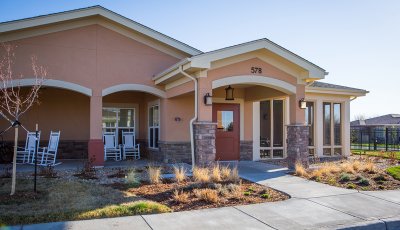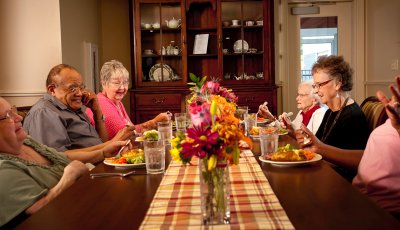For years, experts have called for rethinking the U.S. nursing home model, replacing large “big box” facilities containing hundreds of beds with smaller facilities and fewer residents.
And now with COVID-19 fatalities in nursing homes skyrocketing nationwide, another look is being given to these alternative housing options.
Hundreds of smaller nursing and assisted living homes have sprung up across the country in the past two decades, with 10 to 20 beds for residents, compared with an average of 109 resident beds in regular nursing homes, according to the San Francisco-based Kaiser Family Foundation. Certain features they share appear to help fend off the coronavirus, early reports suggest.
Thousands more are beginning to make the shift to “person-centered design and person-directed practices including household and small house models,” said Penny Cook, president and CEO of Pioneer Network, a national nonprofit network founded in 1997 that promotes such models and philosophies.
Family-style homes
One network of such not-for-profit homes, called the Green House Project, with 10 to 12 beds per home, is reporting notably fewer cases of the coronavirus and fewer deaths than most nursing homes.
The project's own July tally of 256 nursing homes found only 28 COVID-19 cases and three related deaths among residents — and 95 percent of homes were COVID-19-free. In all, its data from January through July 26 show 32.5 confirmed cases per thousand residents, compared with 146 cases per thousand residents in all certified skilled nursing homes. Cases among staff were notably higher than those among residents in June, but July staff numbers were not available.

Courtesy The Green House Homes at Mirasol
Exterior of The Green House Homes at Mirasol in Loveland, Colorado.
By contrast, cases of the novel coronavirus continue to soar in nursing homes nationwide. More than 468,000 cases have been reported since mid-April, with 76,270 deaths, according to a Sept. 18 report from the Kaiser Family Foundation.
"When I think of good infection control, I think this model was made for this moment,” said Susan Ryan, senior director of the Green House Project, adding that home design and outdoor access, as well as early adherence to federal and local health guidelines, have aided many of its locations in curbing the spread of the virus. Ryan said that Green House staff members see their role as advocates for residents. Research has shown that those staff members spend 23 to 31 minutes more per resident per day on direct care activities, compared with those in standard nursing homes, said Green House spokeswoman Meg LaPorte.
Founded in 2003, it now has 300 homes in 32 states, including some assisted living facilities.
"The single most effective aspect is private rooms and bathrooms for each of the residents,” said Elaine Ryan, AARP vice president of state advocacy and strategy integration. Early research has shown that the structure of semiprivate rooms — or what she calls “shared rooms” — was the most critical factor in the spread of infections, she said.

Courtesy St. Martins in the Pines
Residents dine together at St. Martins in the Pines in Birmingham, Alabama.
The project drew recent praise from publications as dissimilar as New York magazine and the New England Journal of Medicine.
A second network, the Household Model, has been spearheaded by Action Pact, a national consulting firm founded in 1996 and based in Milwaukee. The first home opened in 1997 in Minnesota, and more than 400 homes have embraced a model that features 14 to 20 residents, nurses on staff and food cooked to order.
LaVrene Norton, Action Pact's founder and managing director, said that she does not have official tallies of COVID-19 cases in Household Model homes. Action Pact worked with the developers of those homes to help design and build them some 20 years ago, and does not maintain contact with all of them.
"We've kept touch with a number of organizations. I hear that they're all COVID-free” Norton said. “We do know that compared to a more traditional nursing home, there's less opportunity for exposure."
"It really has to do with culture,” Norton added, “like a dedicated staff that absolutely does not want to bring this to the residents of the house."
The Household Model is physically self-contained, with consistent, versatile staff members, she added.
Common features of Green House Project and Household Model homes include:
- Private bedrooms, each with bathroom and shower
- Shared living rooms
- Large tables for dining
- Open kitchen areas
- Easy access to the outdoors
Dining in these homes differs from most traditional nursing homes, which typically have large dining rooms and centralized kitchen areas. In both models, food is prepared in open kitchens in the homes.
The staff at Green House Project homes is typically paid 3 percent to 30 percent more than at other nursing homes, according to a wage survey it conducted several years ago, said Green House spokesperson LaPorte. Its turnover is less, and research has found that the staff has higher job satisfaction, she said.
One expert suggested that more could be learned if the Green House Project crunched its coronavirus numbers differently to better understand how the Green House model affects the COVID-19 rate.
"My main concern is that the Green House homes need to be compared to organizations similar to them,” wrote Robyn Stone, senior vice president for research at LeadingAge, which represents nonprofit care providers, in an email.
"Are the populations served the same? Are they in high-risk areas?” Stone asked. “How does this model compare with other neighborhood, person-centered homes?"
Most Green House Project homes are not-for-profit, and 42 percent of residents receive Medicaid funds, LaPorte said. Most Household Model homes are also not-for-profit, with many residents on Medicaid. In traditional nursing homes, Medicaid residents make up 62 percent of the population.
A new approach
The Green House Project was founded by Bill Thomas, M.D., a Harvard-educated physician. He earlier founded the Eden Alternative, an approach emphasizing older adult care that's focused on people rather than institutions.
The first Green House home opened in Tupelo, Mississippi, in 2003. Thomas had persuaded a top administrator to choose this model rather than replace an old-style nursing home, said Renee Reid, spokesperson for Tupelo-based Methodist Senior Services, which runs Traceway Retirement Communities.
Today, Traceway has 19 Green Houses in Mississippi, with open kitchen and dining areas. “The smell of good food pulls you right out of your room,” Reid said.
Household Model homes also feature open kitchens, where residents can ask staff for food during much of the day, rather than having to eat on a rigid schedule, Norton said.
One Green House feature that stirred attention early on is the use of certified nursing assistants (CNAs), or shahbazim, as home managers, rather than being overseen by registered nurses, the typical system in most nursing homes.
But those concerns have waned over time, with evidence that shahbazim work closely with nurses, said Barbara Bowers, a professor and associate dean for research at the University of Wisconsin-Madison School of Nursing and a Green House expert.
"There is a strong effort [for nurses and CNAs] to work as a team,” Bowers wrote in an email.
Today, a number of Green House homes are built as their own neighborhoods, and others are on larger continuing care campuses, LaPorte said. Such campuses typically include assisted living and independent living homes.
And the model continues to evolve.
A Rochester, New York, nursing home built the first two Green Houses in 2011, embedded in a residential neighborhood in nearby Penfield. There, they blend into the suburban setting, said Tom Harner, spokesperson for St. John's Senior Services.
Inspired by the concept, St. John's is now renovating its traditional six-floor, 455-bed building to follow some Green House tenets.
The onset of COVID-19 has altered the normal rhythms in many homes. Seating 12 people at the traditional large Green House hearth table, for instance, can be a challenge.
"They've had to get creative,” said Ryan, the project's senior director. She has heard of one home that instructed residents to eat in their rooms, and another that staggered six residents at a time around the large table so that they had more distance between them.
https://www.aarp.org/caregiving/basics/info-2020/household-model-nursing-homes-coronavirus.html
No comments:
Post a Comment
Note: Only a member of this blog may post a comment.